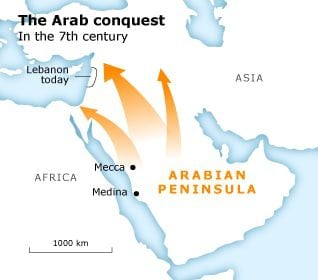
Introduction
In the 7th century, Islamic conquerors, arriving from the Arabian Peninsula, appeared in the region. There had been Arabs in Syria for many centuries – although the origins of the Arabs are unclear, the first reference to their existence is an Assyrian cuneiform mentioning a certain Gindibu, coming from the land of Aribi in 854. In 570, Muhammad ibn Abd Allah, who was to become the Prophet, was born in Mecca. In 613, Muhammad started to preach after he had had his first revelations. In 622, he and his followers went to Yathrib (later named Madinat al-Nabi – the City of the Prophet – or Medina).
This move, the Hegira or Hijra (emigration), and the year in which it took place, 622 CE, became the starting point of the Islamic calendar. The Hegira was also the starting point of the nation-building that Muhammad undertook – with success, although it took him almost ten years. From Medina, he conquered the whole of the Arabian Peninsula and united the Arabs under the banner of Islam. Jews, Christians – Ahl al-Kitab or People of the Book – enjoyed the freedom of religion.
Spread of Islam
After the Prophet’s death in 632, his followers continued his mission. Although there were tribal conflicts in the Arabian Peninsula, the conquest of the regions to the north was rather expeditious, for several reasons. Firstly, the Byzantine Empire had been weakened by wars and internal conflicts, and the population in Asia Minor was rather wary of its rulers. Secondly, the Arabs deployed friendly tribes – related to those already established in the region – to conquer these populations. Thirdly, the Christians in Lebanon and Syria considered the newcomers’ religion as a specific sect of Christianity.
Moreover, the first dynasty of caliphs to govern these countries – the Umayyad, who ruled from the nearby city of Damascus (Muawiya, son of Abu Sufyan, was the first Umayyad caliph) – were quite tolerant towards ‘the People of the Book’. This encouraged the inhabitants to aid their new rulers in their struggle against the former rulers – who managed for a brief while to take back portions of the Lebanese coast – and to transform the coastal cities into citadels.
Umayyads
Abu Sufyan’s son Muawiya, the first governor of ‘Greater Syria’, became the first Umayyad caliph after Hasan ibn Ali and his brother Husayn, Muhammad’s descendants, retreated to Medina.
The wars continued intermittently despite a treaty between Muawiya and Emperor Constantine IV. The war against the Byzantines flared up especially under the fifth Umayyad caliph Abd al-Malik ibn Marwan.
In these wars, the (Christian) Mardaite (Jarajima in Arabic), a tribe in northern Syria, vacillated between serving as soldiers under the Byzantine emperor or as spies and scouts under the caliph.

Eventually, like his forebear Muawiya, Abd al-Malik ibn Marwan concluded a treaty with the Byzantine emperor, Justinian II, paying a heavy tribute. As a result, some of the Mardaite were relocated to Greece and Turkey; others settled in the Lebanese mountains and merged with the rest of the population.
More and more, the population of Lebanon was turning into the mosaic it is today. Descendants of the Phoenicians, Persians, Romans, Greek, Armenians, Syrians, Jews, and others had settled there throughout the centuries. Now, Arabic was beginning to supplant the Syriac dialect of the Aramaic language.
Diversity of Religion
Lebanon was also characterized by its diversity of religion: Jews, several Christian communities – of whom the Maronites formed the greatest majority – and Muslims. The first to convert to Islam were coastal cities, where Greek and Armenians also settled.
Followers of Ali – the Shiites – generally settled in the south of the country and in the mountains. One of the Shia branches of Islam that spread out over Lebanon and Syria, especially in the 9th and 10th centuries, was that of the Ismailis, introduced by the rulers of the time, the Fatimid dynasty, who came from Egypt. The Druze, who was to become an essential part of the Lebanese mosaic, descended from a dissident branch of Ismaili which also originated in Egypt.

